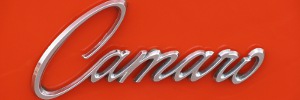















Chevrolet Camaro (1st Generation) |
|---|

|
| Topic Navigation |
|---|
|
Return to Chevrolet Camaro
Wikipedia: Chevrolet Camaro (first generation) Subtopics 1967, 1968, 1969 History Reference Desk Photographs Article Index Merchandise |
History
The following section is an excerpt from Wikipedia's Chevrolet Camaro (first generation) page on 31 July 2016, text available via the Creative Commons Attribution-ShareAlike 3.0 Unported License.
The first-generation Chevrolet Camaro appeared in Chevrolet dealerships in September 1966, for the 1967 model year on a brand-new rear-wheel drive GM F-body platform and was available as a 2-door, 2+2 seat, hardtop (no "B" or center pillar) or convertible with a choice of six-cylinder and V8 power plants. The first-generation Camaro was built through the 1969 model year.
The Camaro's standard drive train was either a 230 cu in (3.8 L) straight-6 engine rated at 140 hp (104 kW) or a 327 cu in (5.4 L) (307 cu in (5.0 L) later in 1969) V8 engine, with a standard three-speed manual transmission. There were 8 (in 1967), 10 (in 1968), and 12 (in 1969) different engines available in 1967-1969 Camaros. The two-speed "Powerglide" automatic transmission was optional. The three-speed "Turbo Hydra-Matic 350" automatic became available starting in 1969. The larger Turbo 400 three-speed automatic was an option on SS396 cars. A four-speed manual was optional.
There was a plethora of other options available all three years, including three main packages:
The RS was an appearance package that included hidden headlights, revised taillights with back-up lights under the rear bumper, RS badging, and exterior bright trim. It was available on any model.
The SS performance package consisted of a 350 or 396 cu in V8 engine and chassis upgrades for better handling and to deal with the additional power. The SS featured non-functional air inlets on the hood, special striping, and SS badging.
The Z/28 performance package was designed (with further modifications) to compete in the SCCA Trans-Am series. It included a solid-lifter 302 V8, 4-speed transmission, power disc brakes, and two wide stripes down the hood and trunk lid.
The idea of offering such a wide variety of "packages" and numerous options was to "blanket" Camaro's end of the personal car market with everything from a nice, plain and docile Six to a gaudy and fire breathing V8.
Almost all of 1967-1969 Camaros were built in the two U.S. assembly plants: Norwood, Ohio and Van Nuys, California. There were also five non-U.S. Camaro assembly plants in countries that required local assembly and content. These plants were located in the Philippines, Belgium, Switzerland, Venezuela, and Peru.
Reference Desk
The Crittenden Automotive Library's "Reference Desk" is a collection of materials that cannot be shared due to copyright restrictions. Information from these resources, however, can be shared. Go to the Reference Desk page for more information.
| Type | Title |
|---|---|
2006  Book Book | The Story of Camaro by John Gunnell & Jerry Heasley; Krause Publications |
| Date | Article | Author/Source |
|---|---|---|
| 19 August 2014 | STOLEN RACECAR  | Ted Barnes |
| 7 January 2016 | New at Summit Racing: Ridetech StreetGrip Suspension Systems for Camaro/Firebird and GM A-Body | Summit Racing Equipment |
| 21 January 2016 | New As Seen on PowernNation TV Parts at Summit Racing: Auto Metal Direct Body Panels for 1967-69 Camaro | Summit Racing Equipment |
| Type & Item # | Name | Details |
|---|---|---|
| Model Kit - Revell 7132 | 427 Yenko SC Coupe | Hot Rod, 1:25 scale |
